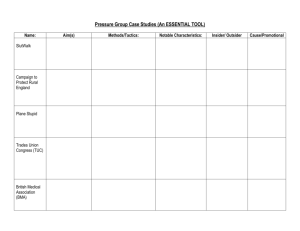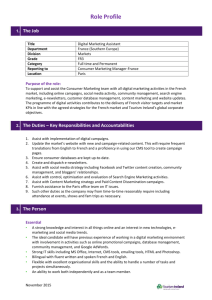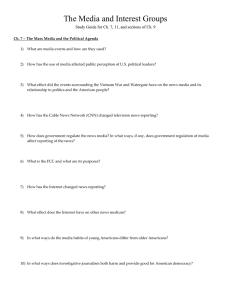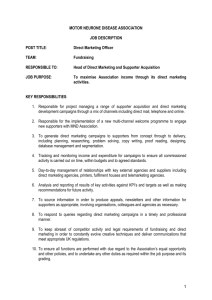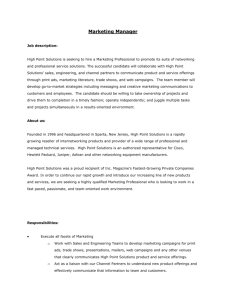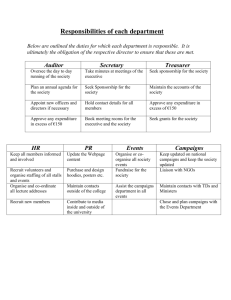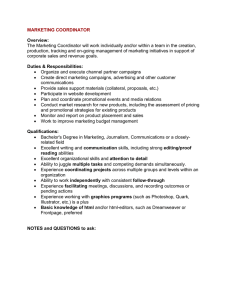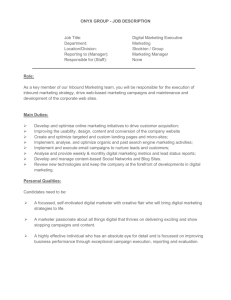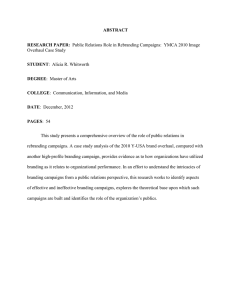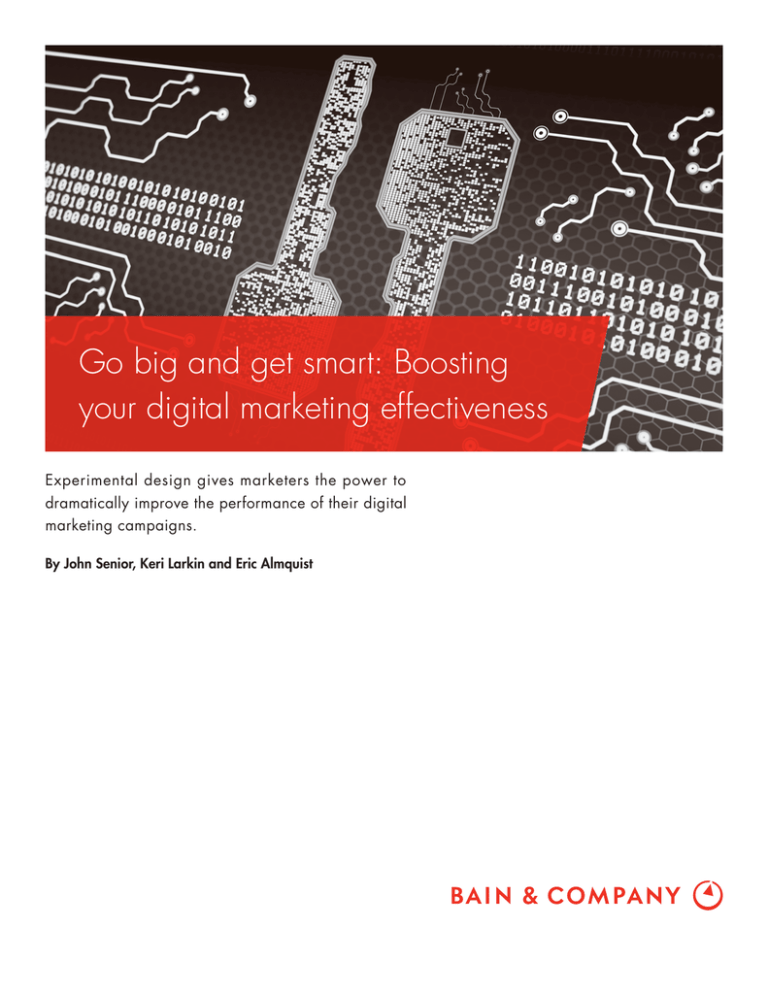
Go big and get smart: Boosting
your digital marketing effectiveness
Experimental design gives marketers the power to
dramatically improve the performance of their digital
marketing campaigns.
By John Senior, Keri Larkin and Eric Almquist
John Senior, Keri Larkin and Eric Almquist are partners with Bain & Company’s
Customer Strategy & Marketing practice. They are based, respectively, in Sydney,
New York and Boston.
Copyright © 2015 Bain & Company, Inc. All rights reserved.
Go big and get smart: Boosting your digital marketing effectiveness
(See our previous Bain Brief “Act now! Triple your direct
marketing effectiveness,” which describes the application of experimental design to direct mail campaigns.)
If you’re trying to maximize the performance of your
digital marketing campaigns, experimental design goes
far beyond the traditional champion/challenger approach
known as A/B testing. What limits A/B testing is the
fact that you can test only a few variables at any one time,
so you have to do many tests in order to determine the
best combinations.
This approach is even more powerful for digital marketing campaigns. Marketers can launch digital campaigns more quickly and can adjust elements such as
formats, messages and offers to tailor campaigns midstream based on what they learn from customer responses.
This enables them to significantly improve response
rates and, more importantly, sales among the target
customer segments (see Figure 1).
Experimental design massively increases the variables that
digital marketers can test simultaneously—product offers,
website design, merchandising, messages, incentives,
interstitials displayed before or after an expected content
page, calls to action, and so on. The effect of all these variables can be determined by testing just a few combinations
and then using mathematical formulas to model the impact
of all the possible combinations.
Complex customer bases, tough nuts to crack
Many organizations already do A/B and simple mutivariate
tests with automated software, usually to test simple features such as colors, images and messages on their websites. More complex experimental design is best suited to
the tough, marquee marketing issues that companies are
trying to address—for example, how to acquire high-value
but difficult-to-attract customer groups or how to cross-sell
Experimentally designed marketing campaigns have
been yielding major improvements to direct mail and
other physical marketing campaigns for many years.
We have seen experimentally designed campaigns increase response and buy rates by three to five times.
Figure 1: Experimentally designed multivariate campaigns have dramatically improved conversion rates
Acquisition
Cross-sell
Response rate (indexed)
Response rate (indexed)
5
5
4.0
4
Retention
Protection rate (indexed)
5.0
5
4
4
3
3
3
2
2
2
1
1.0
1
0
1.0
1
0
Control
Best test offer
2.0
1.0
0
Control
Best test offer
Source: Bain & Company
1
Control
Best test offer
Go big and get smart: Boosting your digital marketing effectiveness
Figure 2: Experimental design tested almost 500 combinations of variables
Variable
1
Message platforms
2
Offers
3
Interstitial locations
4
Interstitial timing
5
6
Levels
Ease of switching
Special offer
Product benefits
Offer A
Offer B
Offer choice
Account overview
My services
Immediately
After short delay
After long delay
Buy flow
“Add to cart”
Leads to cart
“Learn more”
Leads to landing page
“Explore this deal”
Leads to landing page
Incentive
Incentive 1
Incentive 2
Incentive 3
Source: Bain & Company
to customers who historically have not bought multiple
products. It also works best with companies that have large
customer bases, such as telecommunications and cable TV
providers, banks, mortgage lenders, online retailers, and
credit card providers.
From concept to results, this experimentally designed
marketing test took three months, which is much faster
than comparable testing through traditional channels.
We were able to start tracking results within a few days
of launch, and we were able to monitor response fatigue—
that is, the tendency for responses to particular variables
to diminish over time. Using real-time feedback, we
could refresh the messages and incentives to continually
lift response rates.
We recently worked with a major US communications
service provider to create experimentally designed digital
marketing campaigns that would improve cross-selling
to existing customers who historically had not bought
multiple products. We tested 17 variables—including
offers, messages, merchandising, calls to action, and
the timing and location of interstitial pages—in 12 different combinations. At the end of the campaign, we
modeled the response rates for every possible combination
of variables—486 in all (see Figure 2). The best combinations achieved 5 to 10 times the response rate and
2 to 3 times the sales conversion rate of the existing
champion offers. The digital team was able to learn exactly
which combinations of variables cause which segments
of people to click through and buy.
We also found that we could draw insights about a customer from analyzing his or her route through the website—actions such as paying the bill, streaming content,
tinkering with account settings or other behavior—before
a purchase.
Welcome surprises
It’s hard to predict in advance how customers will actually
behave based on how they say they’ll behave or based on
past behavior. Part of the power of experimental design lies
2
Go big and get smart: Boosting your digital marketing effectiveness
in the insights gleaned from actual behavior, the predictive power of the insights and the often unexpected
results such behavior reveals. In our work with the
communications service provider, we found several
unexpected results:
than anticipated and depends on the customer’s
reason for using the website—checking the account, paying a bill, browsing for new products or
another purpose.
•
•
Incentives don’t always spur response. We expected
that certain types of gift cards would spur higher
response rates. But in fact, these particular gift cards
had very little influence. Instead, we found that
high-performing variables included two relatively
soft-sell calls to action.
•
Response may be delayed. Simply showing a user
a targeted pop-up ad page made that person almost
three times more likely to place an order later in
their online session, relative to a user who did not
see the pop-up (see Figure 3).
•
Offer merchandising can have a big impact. Just
changing the merchandising format and presentation of an offer had a huge impact in response
rates for different segments. For example, a good-,
better-, best-offer format proves very effective for
some segments, but a single-offer format performs
better for others.
Is your organization ready?
Before using experimental design for digital marketing
campaigns, it’s important to understand how your digital
and physical operations work together. Online testing has
many advantages over physical campaigns—including a
shorter time from design to results, more flexibility in
changing test parameters midstream, the ability to analyze
Timing depends on context. The timing of when we
launched an interstitial offer had much more effect
Figure 3: Digital multivariate testing provided unanticipated insights
Preferences for offer merchandising
differ by customer segment
Customers are three times more likely to order
if they experienced the test at some point
Projected click rates by offer shown and customer product tier
Order rate
20%
10%
8.4
16.1
8
15
10
8.8
6
Experienced test
10.5
9.7
4
Single
offer
2
3.4
3.5
1.7
No test
5
Good/
Better/
Best
4.9
1.1
0.6
0.3
0
0
Segment 1
Segment 2
Site location 1
Source: Bain & Company
3
Site location 2
Site location 3
Site location 4
Go big and get smart: Boosting your digital marketing effectiveness
insights in real time and a more detailed understanding of
a customer’s journey—but digital testing does have particular
challenges as well:
•
•
Collaboration among functions. Finance and Legal
often need to be involved in the test design, and
business units must commit to and prepare for using
the outcomes that a digital marketing test generates. Business unit heads may be reluctant to change
current marketing campaigns because they’re worried about downside risk. Any team undertaking
experimentally designed marketing tests must prove
that the offers being tested will add value and that
the findings can be implemented at scale.
Managing technical dependencies. Depending on
how your organization captures, stores and accesses
customer data, you may have to tap into multiple
databases and use multiple software vendors. Data
extraction and matching, for instance, can be a substantial task. These dependencies need to be closely
managed by the IT and digital teams.
•
Developing new or better capabilities. Besides the
obvious need for expertise in statistical modeling,
successful experimentally designed marketing tests
hinge on developing other capabilities. One is the
ability to draw up high-definition portraits of the
customer segments based on actual customer characteristics held in company databases, not just on
research, so that you can target more effectively.
•
Offline training and support. Launching experimentally designed digital marketing tests effectively
requires preparing the physical channels to support
the campaigns. Salespeople and chat agents may
need new scripts to help them manage the customer
queries in response to different product offers or
to effectively upsell customers to the highest-value
products. Other frontline staff, such as bank branch
tellers, will need training on how to discuss different
product tiers with different types of customers.
•
Faster decision making. Based on the financial modeling, when testing variables such as promotions
and incentives and their effects on customer response
rates, companies should put in place financial thresholds such as profitability targets that serve as guardrails for subsequent campaigns. These thresholds
help speed up decision making and create a repeatable, efficient test-and-learn model.
•
Building a culture of testing. Many organizations
find that employees will initially resist testing because
it requires them to change the cadence of their work.
But when testing pays off, it increases confidence
and can even be fun, so managers should use successful initiatives to help build a culture of testing.
To get started with experimental design, one approach a
company can take is to first identify the highest-value
marketing problems it is trying to solve and selecting
one of these as a pilot. This allows the company to try
out experimental design campaigns, demonstrate how
to deliver real results quickly and learn where the operational challenges lie. The company can then start to
incorporate such campaigns into its annual marketing
plan to address systematically the major opportunities
in customer acquisition, development and retention.
Software firms such as Optimizely and Maxymiser can
help automate online tests, but marketers still need to
decide what to test and must keep the organization
focused on getting significant financial results. (See
the sidebar “Key questions for achieving the full potential
of digital marketing.”)
With the increasing use of mobile devices and the shift to
digital advertising, maximizing the return on digital advertising and marketing campaigns has become more important. It pays to move beyond testing at the margin and
to focus on those things that will really move demand. By
revealing how different customer segments want to
search, learn, purchase and engage, experimental design
can help an organization launch much higher-performing
digital campaigns.
4
Key questions for achieving the full potential of digital marketing
Are you:
•
Using experimentally designed multivariate campaigns to address the tough, marquee marketing issues?
•
Pushing the boundaries on what you test rather than playing at the margins?
•
Harnessing the power of your digital channels for rapid testing and learning?
•
Seeing meaningful changes to your marketing strategies and improved ROI based on the results
of your tests?
•
Deploying what you learn on a larger scale? Do you have robust test-and-learn capabilities and
processes in place to allow your organization to achieve full potential with marketing?
Shared Ambit ion, True Results
Bain & Company is the management consulting firm that the world’s business leaders come to when they
want results.
Bain advises clients on strategy, operations, technology, organization, private equity and mergers and acquisitions. We develop
practical, customized insights that clients act on and transfer skills that make change stick. Founded in 1973, Bain has 51 offices
in 33 countries, and our deep expertise and client roster cross every industry and economic sector. Our clients have outperformed
the stock market 4 to 1.
What sets us apart
We believe a consulting firm should be more than an adviser. So we put ourselves in our clients’ shoes, selling outcomes, not
projects. We align our incentives with our clients’ by linking our fees to their results and collaborate to unlock the full potential of
their business. Our Results Delivery® process builds our clients’ capabilities, and our True North values mean we do the right
thing for our clients, people and communities—always.
Key contacts:
Americas:
Eric Almquist in Boston (eric.almquist@bain.com)
Keri Larkin in New York (keri.larkin@bain.com)
Asia-Pacific:
John Senior in Sydney (john.senior@bain.com)
Europe,
Middle East
and Africa:
James Anderson in London (james.anderson@bain.com)
For more information, visit www.bain.com

